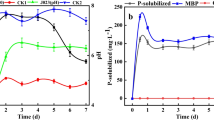Abstract
Two strains of Pseudomonas species (B2 and D5)selected from an array of lead solubilizing and accumulatingbacteria obtained from the effluent contaminated soil samples of abattery manufacturing factory were studied. Increase in pH between 4.0 and 6.0 favoured the growth of isolates: Peaklog10 cfu mL−1 values of 7.1, 7.5 and 8.5 wereobtained at pH 4, 5 and 6, respectively.Cell bound lead concentrations for B2 (0.34 mg mL−1)and D5 (0.30 mg mL−1) obtained by direct contact withPbs were greater than lead concentrations of 0.89 and 0.25 mg mL−1 for B2 and D5, respectively,obtained in dialyzed cultures. These cell bound lead concentration in undialyzed cultures were alsogreater than lead concentrations of 0.03 and 0.07 mg mL−1 for B2 and D5 in culture supernatants. Glucose addition did nor improve lead accumulation in the isolates.Exploitation of such isolates for the biotreatment of lead ladeneffluent was conducted.
Similar content being viewed by others
REFERENCES
Alexander, M.: 1977, Introduction to Soil Microbiology, John Wiley & Sons, New York, 235 pp.
Arrouays, D., Moench, M., Amans, V. and Gomez, A.: 1995, ‘Short range variability of fallout of lead in contaminated soil’, Can. J. Soil Sci. 76, 73–81.
Benka-Coker, M. O.: 1991, ‘Studies of the Effect of Crude Oil and Heavy Metal Contamination of Soil and Water on the Microbial Populations at the Kokori Flare Site, Bendel State, Nigeria, Ph. D. Thesis, University of Benin, 165 pp.
Biney, C., Amuzu, A. Y., Calamari, D., Kaba, N., Mbome, I. L., Naeve, H., Ochumba, P. B., Osibanjo, O., Radegonde, V. and Saad, M. A.: 1994, ‘Review of Heavy Metals’, Review of Pollution in the African Aquatic Environment, CIFA Technical Paper 25, 33–51.
Blackwell, K. J., Singleton, T. and Tobin, J.: 1995, ‘Metal cation uptake by Yast: A review’, Appl. Microbiol Biotechnol. 43, 579–584.
Brady, D. and Duncan, A.: 1994, ‘Bioaccumulation of metal cations by Saccharomyces cerevisiae’, App. Microbiol Biotechnol. 41, 149–159.
Buchanan, R. E. and Gibbons, N. E.: 1974, Bergey's Manual of Determinative Bacteriology, 8th edn., Williams and Wilkens Comp., Baltimore, 1268 pp.
Chaudry, R., Ashish, P. and Mukerji, K.: 1989, ‘Effect of Some Atmospheric Pollutants on Micro-Organisms’, in K. Mukerji, V. Singh, and K. Garg (eds.), Frontiers in Applied Microbiology, Rastogi and Co., India, pp. 84–89.
Christensen, E. R., Scherfig, J. and Dixon, P. S.: 1979, ‘Effects of manganese, copper and lead on Selenastrum capricornutum and Chlorella stigmatophora, Water Res. 13, 79–92.
Cole, M.: 1979, ‘Solubilization of heavy metal sulfides by heterotrophic soil bacteria’, Soil Sci. 127, 313–317.
Cowan, S. T. and Steel, K. J.: 1994, Manual for the Identification of Medical Bacteria, 2nd edn., Cambridge University Press, 238 pp.
Doelman, P. and Haanstra, L.: 1979, ‘Effect of lead on soil respiration and dehydrogenase’, Soil Biol. Biochem 11, 47–480.
Francis, A. and Dodge, C.: 1986, ‘Anaerobic bacterial dissolution of lead oxide’, Arch. Environ. Contam. Toxicol. 15, 611–616.
Gadd, G. M.: 1990, ‘Metal Tolerance’, in Microbes of Extreme Environments, Open University Press, Britain, 210 pp.
Hanson, N. W.: 1973, Official Standardized and Recommended Methods of Analysis, Society for Analytical Chemistry, London, U.K., 495 pp.
Huang, C. P., Westman, D., Quirk, K. and Huang, J. P.: 1988, ‘The removal of Cd2+ from dilute aqueous solution of fungal absorbent’, Water Sc. Tech. 20, 369–376.
Hughes, M. and Poole, R.: 1989, Metals and Micro-Organisms, Chapman and Hall, U.K., 396 pp.
Margesin, R. and Schinner, F.: 1996, ‘Baterial Heavy Metal Tolerance – Extreme Resistance to Nickel in Arthrobacter sp.’, J. Basic Microbiol. 36, 269–282.
Saguir, M. F. and Nadia de Nanca, M. C.: 1996, ‘Organic acid metabolism under different glucose concentration of Leuconostoc oenes from Wine’, J. Appl. Bact. 81, 394–399.
Summers, A. O. and Silver, S.: 1878, ‘Microbial transportation of metals’, Ann. Rev. Microbiol. 32, 637–672.
Tornabene, T. and Edwards, H.: 1972, ‘Microbial uptake of lead’, Science 176, 1334–1335.
Author information
Authors and Affiliations
Rights and permissions
About this article
Cite this article
Ekundayo, E.O., Killham, K. Lead Solubilization and Accumulation by Two Strains of Pseudomonas Obtained from a Contaminated Alfisol's Effluent in Southwestern Nigeria. Environ Monit Assess 71, 243–254 (2001). https://doi.org/10.1023/A:1011827716290
Issue Date:
DOI: https://doi.org/10.1023/A:1011827716290




